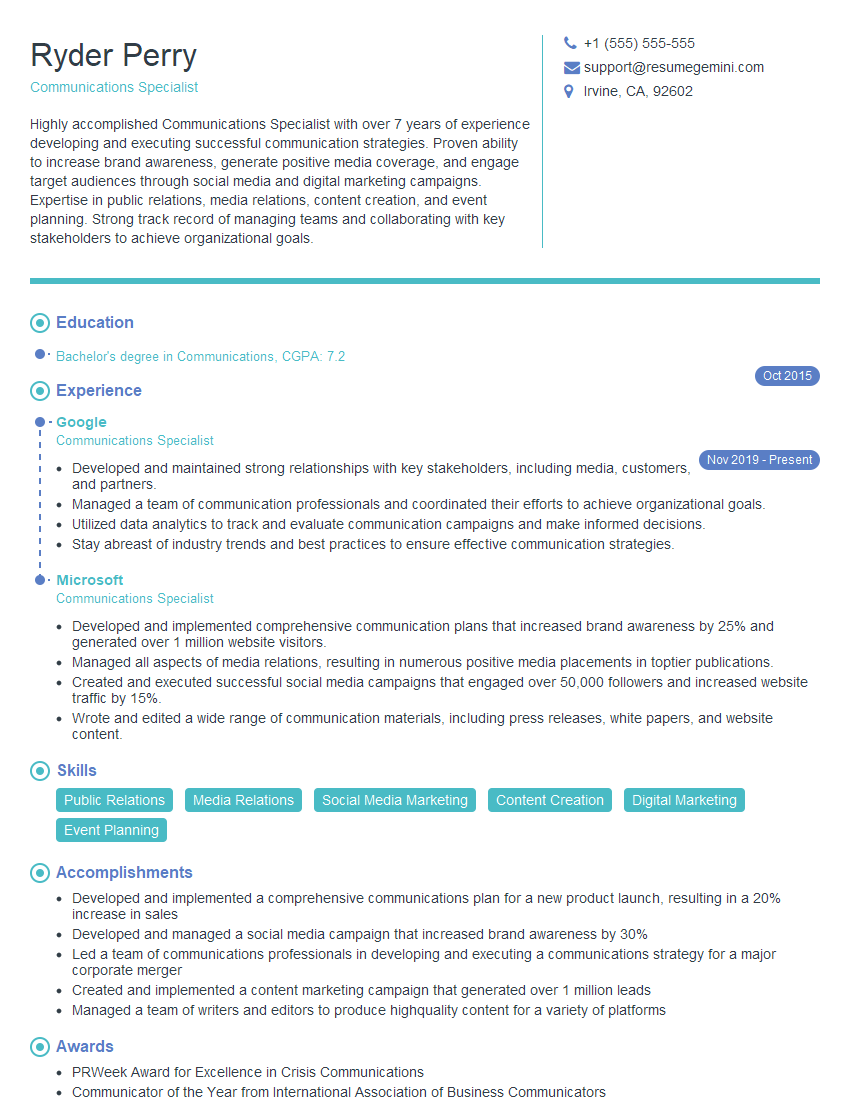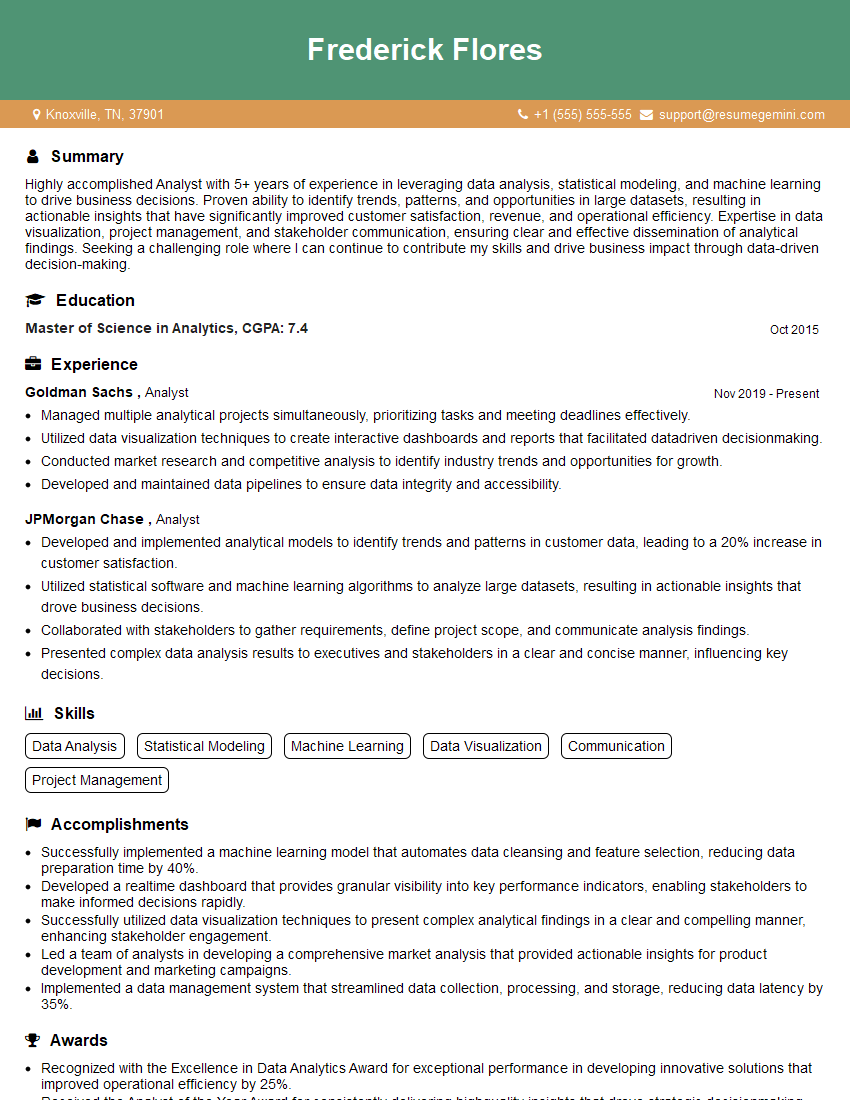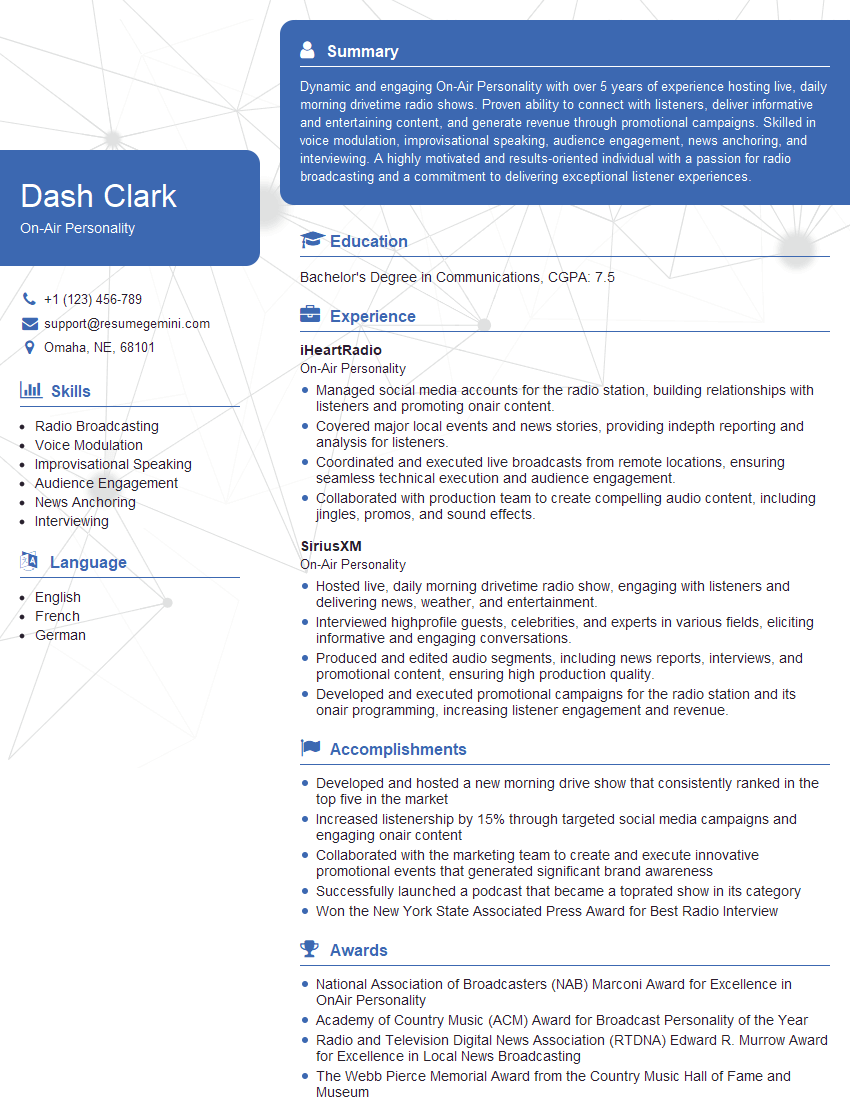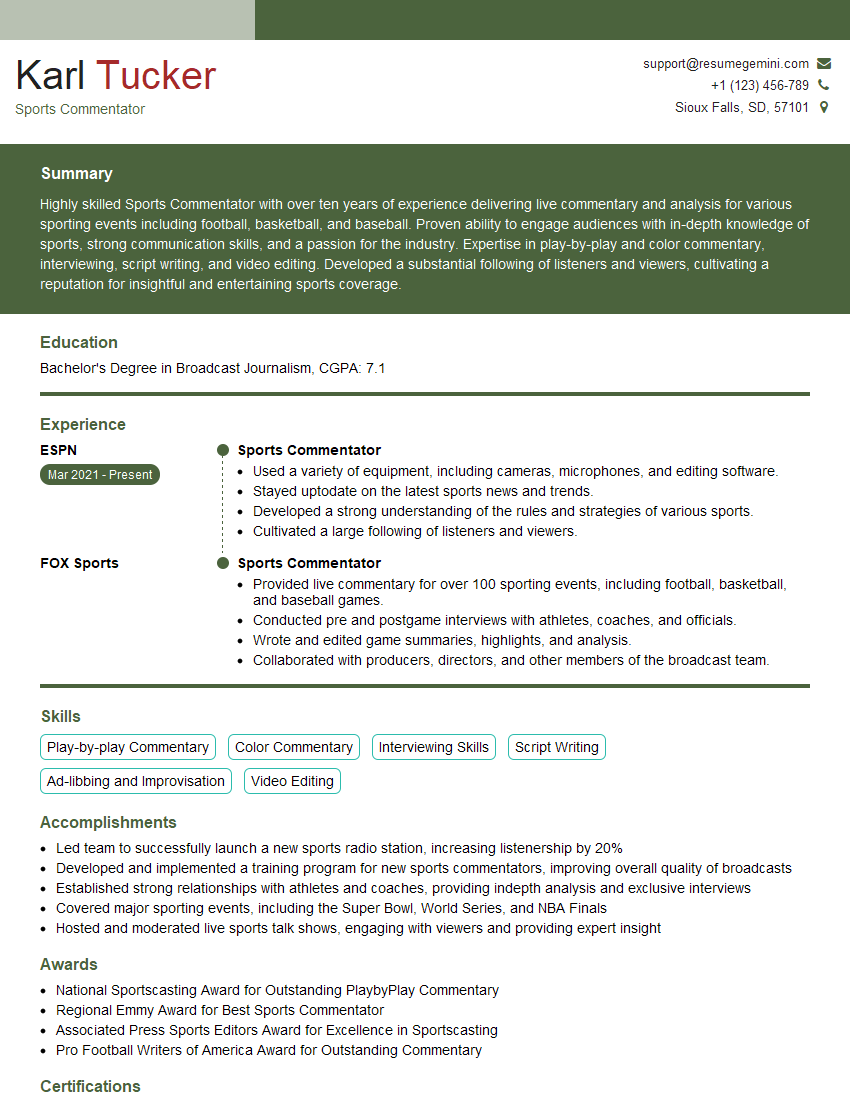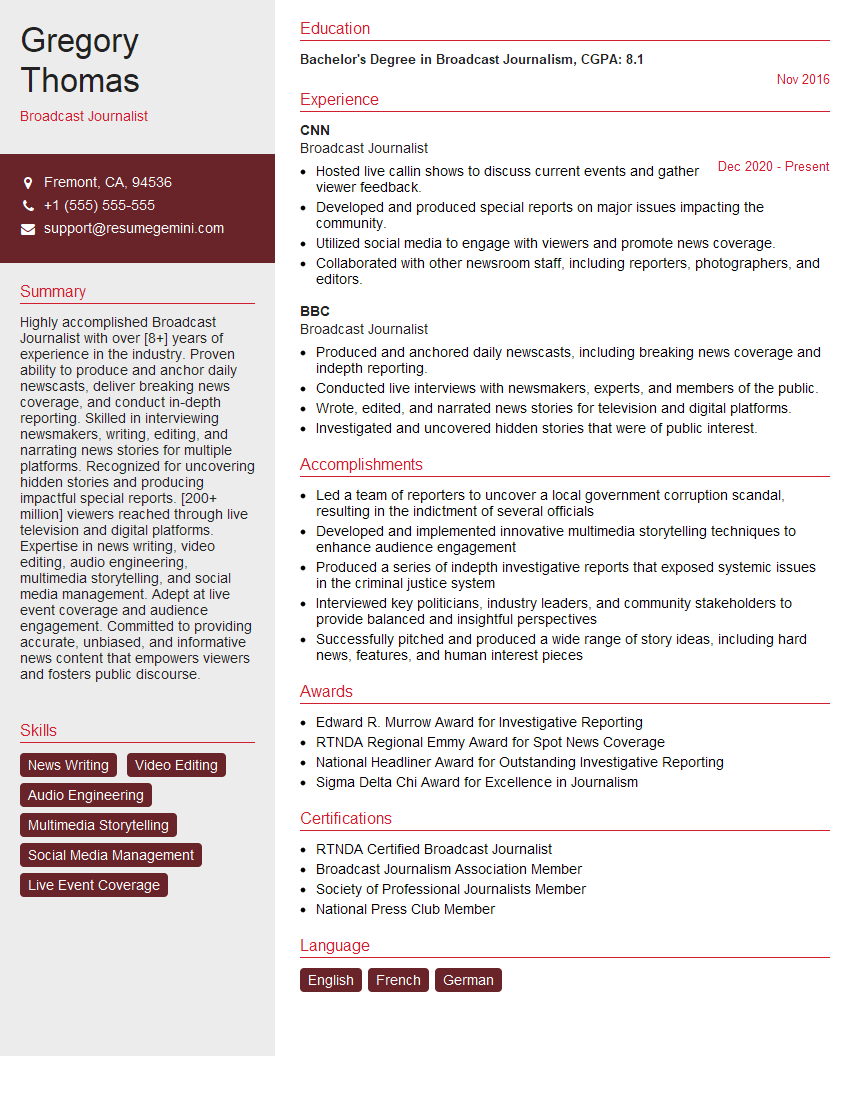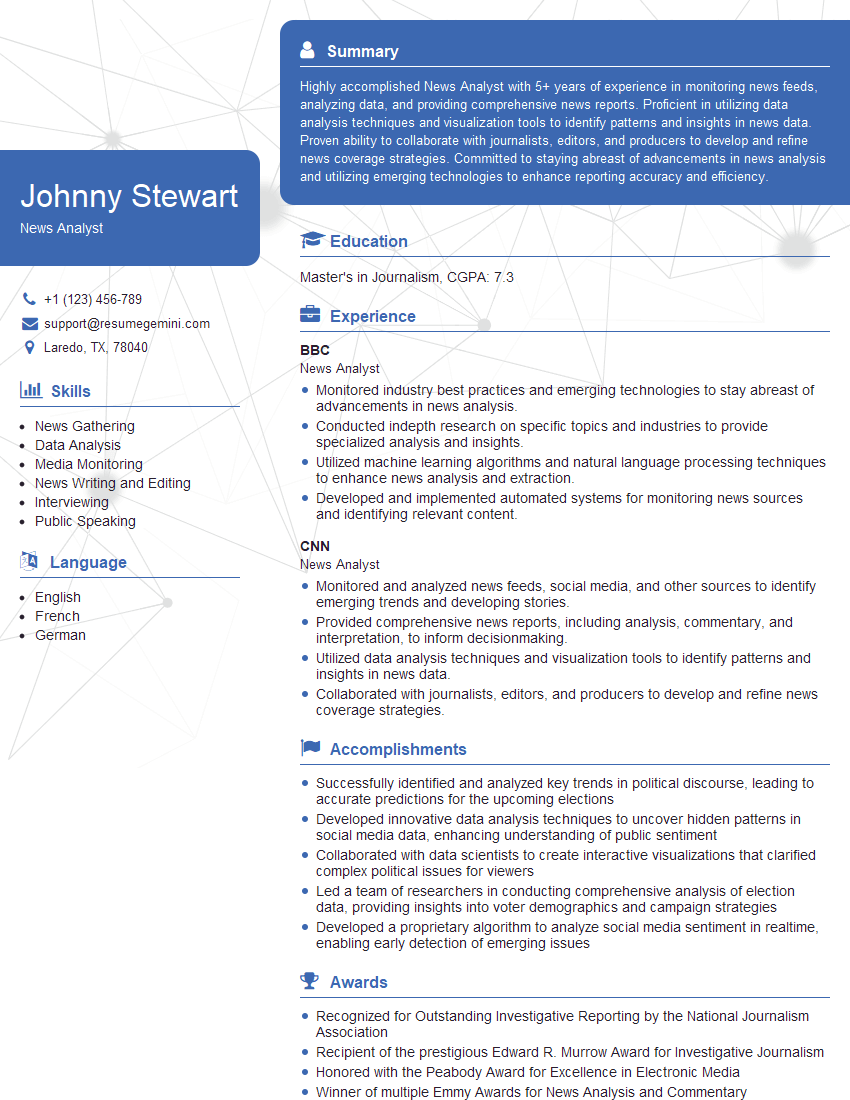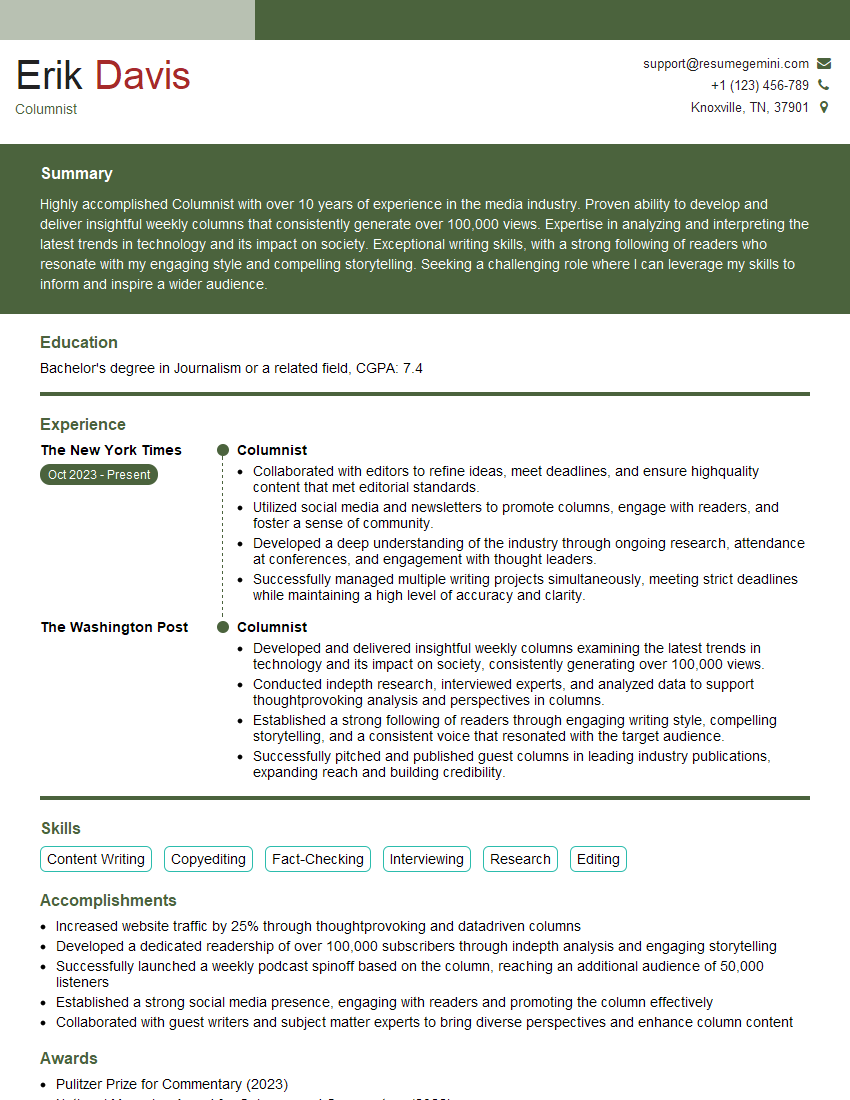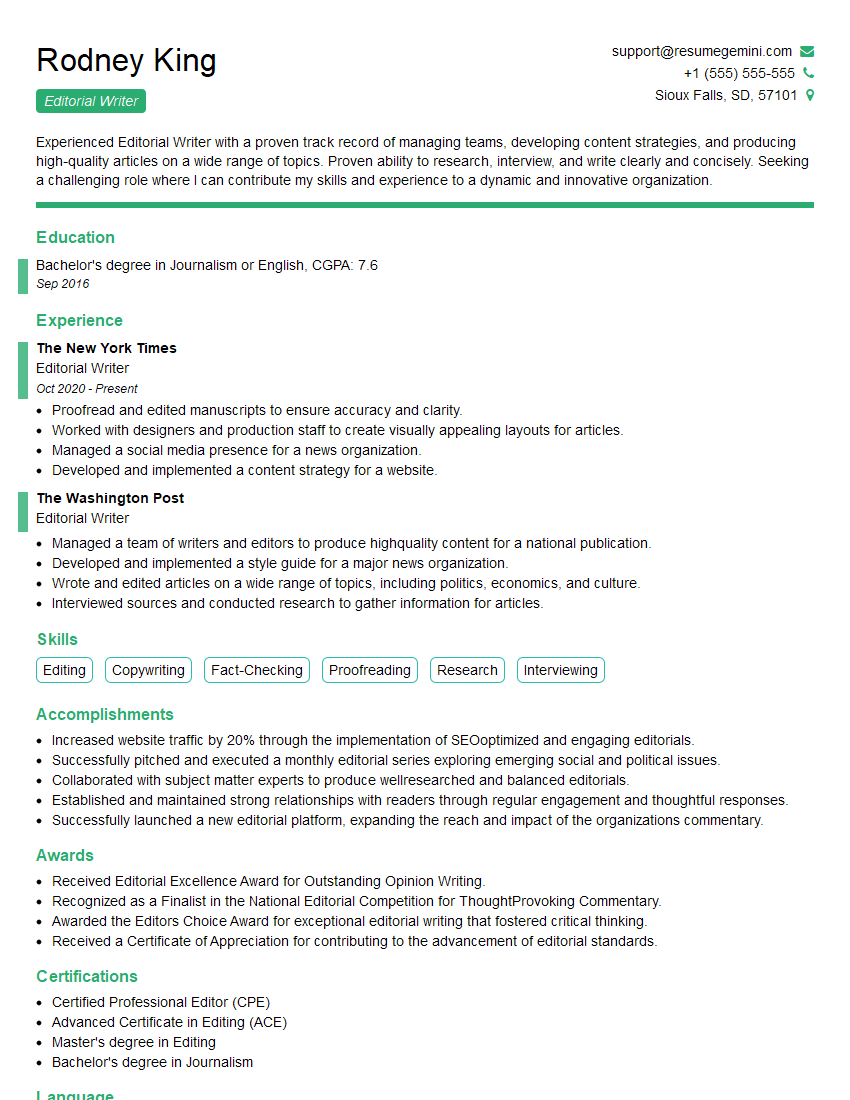Are you ready to stand out in your next interview? Understanding and preparing for Commentary Preparation interview questions is a game-changer. In this blog, we’ve compiled key questions and expert advice to help you showcase your skills with confidence and precision. Let’s get started on your journey to acing the interview.
Questions Asked in Commentary Preparation Interview
Q 1. Describe your process for researching a commentary topic.
My research process for a commentary topic is rigorous and multifaceted. It begins with a deep dive into the subject matter, utilizing a variety of sources to gain a comprehensive understanding. This includes reputable news articles, academic journals, government reports, and expert interviews. I meticulously analyze data and statistics to identify trends and patterns, ensuring I present accurate and well-supported arguments.
- Keyword Research: I start by identifying key terms and phrases related to the topic to refine my search and ensure I’m finding the most relevant information.
- Source Evaluation: I critically evaluate each source, considering its credibility, bias, and potential conflicts of interest. I prioritize sources with a strong track record of accuracy and objectivity.
- Data Analysis: I carefully examine any data or statistics presented, paying close attention to methodology and potential limitations. I look for contradictory information and explore multiple perspectives.
- Expert Consultation: When appropriate, I reach out to experts in the field for their insights and perspectives. This allows me to add depth and nuance to my commentary.
For example, when researching a commentary on climate change policy, I wouldn’t just rely on opinion pieces. My research would include peer-reviewed scientific papers, IPCC reports, economic models, and interviews with climate scientists and policymakers.
Q 2. How do you structure a commentary piece for maximum impact?
The structure of a compelling commentary is crucial for maximizing its impact. I typically follow a clear and logical progression:
- Hook: I begin with a strong opening – a compelling statistic, a relevant anecdote, or a provocative question – to immediately grab the reader’s attention and set the stage for my argument.
- Background: I provide concise background information to contextualize the issue and establish the relevance of my commentary. This helps the reader understand the broader landscape before diving into my specific arguments.
- Argument/Thesis Statement: I clearly state my central argument or thesis statement, making it explicit what position I’m taking.
- Supporting Evidence: I present compelling evidence, including facts, statistics, examples, and expert opinions, to support my claims. Each point should be logically connected to the overall argument.
- Counterarguments and Rebuttals: I acknowledge and address potential counterarguments, demonstrating a nuanced understanding of the issue. This enhances my credibility and showcases critical thinking.
- Conclusion: I conclude by summarizing my main points and offering a clear, concise, and impactful takeaway message. This leaves the reader with a lasting impression and a call to action, if appropriate.
Think of it like building a case in court; you need a strong opening statement, supporting evidence, and a rebuttal of the opposing side to win over your audience (readers).
Q 3. Explain your approach to writing concise and engaging commentary.
Writing concise and engaging commentary requires a focused approach. I strive for clarity, precision, and conciseness in every sentence. I use strong verbs, avoid jargon, and employ varied sentence structures to maintain reader interest. I use storytelling techniques to make the information relatable and memorable. This involves incorporating real-world examples and anecdotes to illustrate points and connect with the reader on an emotional level.
- Active Voice: Using active voice makes the writing more direct and impactful. For example, instead of ‘The report was written by the committee,’ I’d write ‘The committee wrote the report.’
- Show, Don’t Tell: I focus on using vivid language to paint a picture for the reader, rather than simply stating facts. For example, instead of ‘The city is polluted,’ I might write ‘A thick smog hung heavy in the air, obscuring the city skyline.’
- Strong Verbs: Using strong verbs adds energy and impact to the writing. For example, instead of ‘The politician spoke,’ I might write ‘The politician thundered.’
Imagine explaining a complex scientific concept to a non-scientist; you wouldn’t use technical jargon but rather relatable analogies and examples to help them understand.
Q 4. How do you adapt your commentary style to different audiences?
Adapting my commentary style to different audiences is crucial for effective communication. I consider the audience’s background knowledge, interests, and level of expertise when crafting my piece. For a general audience, I would use simpler language and avoid highly technical terms. For a more specialized audience, I can incorporate more technical detail and assume a higher level of prior knowledge.
- Language: I adjust the tone and vocabulary to match the audience’s sophistication. A piece for a scientific journal will differ significantly from one intended for a general newspaper readership.
- Examples: I use examples that resonate with the target audience. For example, a commentary on economic policy aimed at business leaders would use different examples than one written for the general public.
- Framing: The overall ‘frame’ of the commentary – the angle and focus – may also shift depending on the intended audience.
For instance, a commentary on artificial intelligence for a group of computer scientists will differ significantly from one meant for a lay audience. The former might delve into algorithmic details while the latter would focus on broader societal implications.
Q 5. How do you ensure accuracy and objectivity in your commentary?
Accuracy and objectivity are paramount in commentary. I ensure accuracy by meticulously verifying facts, figures, and data from reputable sources. I avoid making unsubstantiated claims or relying on biased sources. Objectivity is maintained by presenting diverse perspectives fairly, acknowledging opposing viewpoints, and avoiding emotionally charged language.
- Multiple Sources: I cross-reference information from multiple independent sources to ensure accuracy and avoid reliance on a single, potentially biased source.
- Fact-Checking: I meticulously fact-check all claims, statistics, and quotes using reliable sources.
- Balanced Presentation: I present both sides of an issue fairly, acknowledging the strengths and weaknesses of each argument. I aim to show, not tell, allowing readers to draw their own conclusions.
Imagine a commentary on a controversial political issue. Maintaining objectivity involves fairly representing both sides of the debate, even if I personally lean toward one side. I would present the facts and arguments of both sides and then offer my own analysis based on those facts.
Q 6. Describe your experience with fact-checking and source verification.
My experience with fact-checking and source verification is extensive. I understand the importance of verifying information from multiple reputable sources. I utilize various fact-checking techniques, including cross-referencing information, consulting primary sources whenever possible, and carefully examining the methodology of studies or reports. I’m adept at identifying potential biases in sources and accounting for them in my analysis.
- Primary Sources: I prioritize primary sources (original documents, data sets, etc.) whenever feasible to ensure accuracy. Secondary sources are critically evaluated for potential biases or misinterpretations.
- Cross-Referencing: I always cross-reference information from multiple independent sources to ensure consistency and reliability.
- Source Citation: I consistently and accurately cite all sources used in my commentary, allowing readers to independently verify the information.
For example, when writing about a historical event, I wouldn’t rely solely on a single history book. I would consult multiple books, primary source documents, and perhaps even academic articles to ensure a comprehensive and accurate account.
Q 7. How do you handle conflicting viewpoints when preparing commentary?
Handling conflicting viewpoints is a crucial aspect of preparing objective commentary. I approach this by acknowledging and presenting different perspectives fairly. I analyze the evidence supporting each viewpoint and identify areas of agreement and disagreement. I don’t shy away from presenting conflicting evidence; rather, I use it to highlight the complexity of the issue and encourage critical thinking in my audience.
- Present Both Sides: I ensure that all relevant perspectives are presented, even those I disagree with. This allows for a balanced and nuanced understanding of the issue.
- Identify Areas of Agreement and Disagreement: I clearly highlight the points where different perspectives converge and diverge, showing the reader the complexity of the issue.
- Analyze Supporting Evidence: I analyze the evidence supporting each viewpoint, critically evaluating its strength and limitations. This allows me to draw informed conclusions about the relative merits of each perspective.
For example, in a commentary on healthcare reform, I would present the arguments for both universal healthcare and a market-based system, highlighting the supporting evidence and potential drawbacks of each. I would then offer my analysis, drawing on this evidence to support my conclusion.
Q 8. How do you incorporate data and statistics effectively into your commentary?
Effectively incorporating data and statistics into commentary requires a nuanced approach. It’s not simply about throwing numbers at the audience; it’s about using them to support your argument, paint a clearer picture, or add weight to your analysis.
Firstly, I always ensure the data is relevant and comes from credible sources. This builds trust and credibility with the audience. I then choose the right type of statistic to tell my story. A simple percentage might suffice for one point, while a more complex chart or graph could be needed to illustrate a trend or comparison. For example, instead of simply stating ‘Team A played better,’ I might say, ‘Team A held a 60% possession advantage in the second half, directly leading to their winning goal’.
Secondly, I strive for clarity and simplicity. Complex statistical concepts need to be explained in an accessible way. Think of it like translating technical jargon into plain English. I avoid overwhelming the audience with too many numbers; I select the most impactful data points to make my case effectively. Finally, visualization is key. Using charts, graphs, or even simple bullet points can make the data easier to understand and more engaging for the viewer or reader.
Q 9. How familiar are you with different commentary formats (e.g., broadcast, print, online)?
I’m highly familiar with various commentary formats, and my approach adapts to the specific medium. Broadcast commentary, for example, demands conciseness, a conversational tone, and a focus on immediate action and analysis. It’s often time-sensitive, requiring quick thinking and adaptation to the unfolding events. I’ve experience delivering live commentary on radio and television, adapting my style to the pace and audience engagement of each platform.
Print commentary offers more space for in-depth analysis and a more considered, reflective tone. You can delve deeper into statistics and background information. Online commentary allows for multimedia integration – photos, videos, even interactive elements – providing a richer and more engaging experience. I’m adept at crafting pieces for online news sites, blogs, and social media, understanding the unique characteristics of each platform and audience.
Q 10. How do you manage deadlines and time constraints in commentary preparation?
Managing deadlines and time constraints is crucial in commentary preparation. My approach involves meticulous planning and efficient workflow. It starts with a clear understanding of the deadline and the scope of the assignment. I break down the task into smaller, manageable steps, allocating specific time slots for research, writing, editing, and fact-checking.
I utilize tools like project management software and calendars to keep track of progress and ensure I stay on schedule. Prioritization is essential; I focus on the most critical aspects of the commentary first, ensuring the core message is delivered effectively, even if some supplementary details are trimmed due to time constraints. I also practice efficient research techniques, leveraging online databases and resources to quickly gather the necessary information. In high-pressure situations, I have found that a calm and organized approach is essential in delivering quality work within the given time frame.
Q 11. Describe your experience using media production tools relevant to commentary creation.
My experience encompasses a range of media production tools relevant to commentary creation. I’m proficient in audio recording and editing software such as Audacity and Adobe Audition, using them to refine audio recordings for broadcast or podcast use. For video projects, I’m skilled in using video editing software such as Adobe Premiere Pro and Final Cut Pro, incorporating visuals, graphics, and data visualizations into my commentary pieces.
I’m comfortable working with content management systems (CMS) to publish online commentary and integrate social media tools for audience engagement. I also have experience with graphic design software such as Adobe Photoshop and Illustrator, creating visually appealing elements to complement my written and spoken work. This holistic approach ensures I can create engaging and effective commentary across various media platforms.
Q 12. How do you handle criticism of your commentary?
Handling criticism is an integral part of being a commentator. I approach criticism constructively, viewing it as an opportunity for growth and improvement. I don’t take all criticism personally; I analyze it objectively, separating valid points from subjective opinions. If the criticism is specific and well-reasoned, I carefully evaluate it to see if it highlights areas where I can enhance my analysis or presentation style.
For instance, feedback on the clarity of my explanations or the effectiveness of my data visualizations would be valuable inputs. On the other hand, unconstructive or overly personal attacks are usually dismissed. Continuous self-reflection and a commitment to learning are vital; each commentary piece is a chance to refine my skills and approach.
Q 13. Describe a situation where your commentary faced challenges. How did you overcome them?
One challenging situation involved preparing commentary on a rapidly evolving political situation. The information landscape was dynamic, with new developments and conflicting reports emerging constantly. This presented a significant challenge in terms of maintaining accuracy and providing timely analysis.
To overcome this, I implemented a rigorous fact-checking process, cross-referencing information from multiple credible sources. I also established a flexible writing structure, allowing me to adapt and incorporate new information as it became available. I actively monitored news feeds and social media for updates and used my network of contacts to gather information as quickly as possible. The key was to remain calm, focused, and adaptable in this environment. It resulted in a nuanced commentary that acknowledged the complexity of the evolving situation, ultimately building credibility.
Q 14. Explain your experience working with editors or producers.
My experience working with editors and producers has been extremely positive and collaborative. I value their expertise and input throughout the commentary development process. I view them as partners, not just supervisors. Open communication is essential; I actively seek feedback on my drafts and ideas, ensuring alignment with the publication’s goals and target audience.
I understand that editors and producers often have valuable insights into audience expectations and formatting requirements. I consider their suggestions carefully, incorporating changes that enhance the quality and effectiveness of my commentary. Working collaboratively with others, including graphic designers and other media specialists, is a crucial skill in creating impactful commentary. It is the collaborative effort that generates the best results and builds successful products.
Q 15. How do you ensure your commentary aligns with the overall editorial strategy?
Aligning commentary with editorial strategy is paramount. It ensures consistency of voice, message, and overall brand identity. This involves a thorough understanding of the publication’s mission, target audience, and the overarching themes it prioritizes.
For instance, if a publication focuses on in-depth analysis of international affairs, my commentary would reflect that, avoiding frivolous topics or overly sensationalized reporting. I would familiarize myself with past articles and editorials to understand the preferred style and tone. I would also actively communicate with editors, seeking feedback and guidance on the direction of my commentary before, during, and after the writing process to ensure alignment. This might involve submitting a detailed outline for review or participating in editorial meetings to discuss upcoming topics.
Career Expert Tips:
- Ace those interviews! Prepare effectively by reviewing the Top 50 Most Common Interview Questions on ResumeGemini.
- Navigate your job search with confidence! Explore a wide range of Career Tips on ResumeGemini. Learn about common challenges and recommendations to overcome them.
- Craft the perfect resume! Master the Art of Resume Writing with ResumeGemini’s guide. Showcase your unique qualifications and achievements effectively.
- Don’t miss out on holiday savings! Build your dream resume with ResumeGemini’s ATS optimized templates.
Q 16. How do you incorporate current events into your commentary effectively?
Integrating current events into commentary requires a keen awareness of the news cycle and the ability to connect them meaningfully to larger trends or ongoing narratives. Simply reporting the news isn’t sufficient; the goal is to provide insightful analysis and context.
Imagine a significant policy announcement. Instead of merely summarizing the announcement, effective commentary would delve into its potential implications, historical context, contrasting viewpoints, and likely long-term effects. This requires quick research, critical thinking, and the capacity to synthesize information effectively. Using recent statistics or data to back up claims is also crucial for credibility.
Q 17. How do you maintain a neutral tone while conveying your perspective?
Maintaining neutrality while presenting a perspective is a delicate balance. It’s about presenting arguments fairly, acknowledging counterarguments, and avoiding loaded language or emotionally charged rhetoric.
For example, if writing about a controversial policy, I’d present the arguments for and against it, citing credible sources for each side. Instead of stating “This policy is disastrous,” a more neutral approach might be “This policy has drawn significant criticism for its potential impact on X and Y, while supporters argue it will achieve Z.” I always aim for objectivity by avoiding unsubstantiated claims, using clear and precise language, and offering evidence to support my analysis.
Q 18. How do you prioritize information and select key points for your commentary?
Prioritizing information involves a strategic approach to selecting the most relevant and impactful points. This begins with a clear understanding of the commentary’s purpose and intended audience.
I use a process of elimination. I start with a broader overview of the subject, then identify the key arguments or themes. I evaluate each point based on its significance, novelty, and relevance to the overall narrative. Less important details are eliminated to maintain clarity and focus. Using a mind map or outline helps to visualize the connections between different points and ensure a logical flow.
Q 19. How do you use language to effectively convey complex information?
Conveying complex information effectively necessitates clear, concise language, and avoiding jargon whenever possible. I use analogies, metaphors, and real-world examples to illustrate abstract concepts, making them easier to grasp.
Instead of using technical terms, I explain the concept in simpler language. For instance, instead of saying “the algorithm exhibited a high degree of variance,” I might say “the results were unpredictable and inconsistent.” I also break down complex issues into smaller, more manageable chunks, using headings, subheadings, and bullet points to enhance readability and comprehension.
Q 20. How familiar are you with AP Style or other style guides?
I am proficient in AP Style and other common style guides. Consistency in style and grammar is essential for professional writing. AP Style, for example, provides a set of rules for writing, including punctuation, capitalization, number usage, and abbreviation.
Adherence to style guides ensures clarity, consistency, and professionalism in the final product. I am also familiar with other styles like Chicago and MLA, adapting my approach depending on the specific publication’s requirements. My proficiency extends beyond simple adherence; I understand the *why* behind the rules, which allows me to make informed choices regarding style and tone.
Q 21. How do you respond to live questions or impromptu commentary requests?
Responding to live questions or impromptu commentary requests requires quick thinking and adaptability. Preparation is key. I always try to stay informed on current events and develop a broad understanding of relevant topics.
When faced with an unexpected question, I begin by acknowledging the question, confirming my understanding, and taking a moment to gather my thoughts. I then attempt to answer concisely and accurately, focusing on the most important aspects. If I’m unsure of an answer, I acknowledge my uncertainty and promise to follow up with additional information later. I prioritize maintaining composure and professionalism, even under pressure.
Q 22. How do you stay up-to-date with the latest news and trends in your field?
Staying current in commentary preparation requires a multi-pronged approach. It’s not just about reading headlines; it’s about deep understanding and nuanced perspectives.
News Aggregators and Specialized Publications: I utilize a variety of news aggregators like Google News, Apple News, and specialized industry publications relevant to my commentary focus. This ensures I capture a broad range of viewpoints and avoid echo chambers.
Direct Engagement with Sources: I actively engage with original sources – research papers, government reports, and interviews with experts. This allows me to verify information and develop informed opinions, rather than simply reacting to headlines.
Social Media Monitoring (with caution): While social media can reflect public sentiment, I use it cautiously, focusing on verified accounts and reputable organizations to avoid misinformation. It’s a valuable tool for understanding immediate reactions, but not a primary source of factual information.
Continuous Learning: I dedicate time to professional development, including attending workshops, webinars, and conferences focused on journalism ethics, media trends, and specific areas of expertise related to my commentary.
Q 23. How do you adapt your commentary to meet time constraints (e.g., radio, television)?
Adapting commentary to time constraints is a crucial skill. It requires a clear understanding of the medium and a disciplined approach to concise communication.
Radio: For radio, brevity is key. I focus on a strong opening statement, one or two key supporting points, and a memorable conclusion. The pacing needs to be conversational, and I might use sound bites or impactful examples to enhance engagement within the limited timeframe.
Television: Television allows for a slightly more visual approach. I’ll incorporate visuals or data points that support the commentary. The language remains concise, but there’s room to build a narrative with more detail than radio, while still respecting the time limit. I’ll practice delivering the commentary to ensure smooth transitions.
Preparation is Paramount: Regardless of the medium, I always prepare multiple versions of the commentary – a full-length version, a shorter version, and even bullet points outlining key ideas. This flexibility ensures I can adapt quickly to any time adjustments.
Q 24. Describe your experience in using social media to promote commentary.
Social media is a powerful tool for promoting commentary, but it requires a strategic approach. It’s not about self-promotion; it’s about adding value to the conversation.
Platform Selection: I strategically choose platforms based on my target audience. For example, Twitter is ideal for concise commentary and quick updates, while LinkedIn might be better suited for in-depth discussions within professional circles. YouTube can be used for longer-form video commentaries.
Content Strategy: I create compelling snippets of my commentary – quotes, key takeaways, or thought-provoking questions – to share on social media. This encourages engagement and drives traffic to the full version of my work.
Interaction and Engagement: I actively engage with my audience by responding to comments and questions. This builds a community and fosters trust. I also participate in relevant discussions and hashtags to increase visibility.
Analytics: I track social media analytics to understand what content resonates most with my audience and to refine my strategy accordingly.
Q 25. How do you identify and avoid potential biases in your commentary?
Identifying and mitigating bias is paramount in commentary. It requires constant self-reflection and a commitment to objectivity.
Self-Awareness: I regularly reflect on my own perspectives and potential biases. This involves actively considering my personal experiences, beliefs, and potential blind spots that might influence my commentary.
Multiple Perspectives: I actively seek out diverse perspectives and sources to ensure a balanced view. I avoid relying solely on information that confirms my pre-existing beliefs.
Fact-Checking and Verification: Rigorous fact-checking is crucial. I use multiple sources to verify information and avoid spreading misinformation or perpetuating false narratives.
Feedback Mechanisms: I encourage feedback from trusted colleagues, editors, and even the audience. This helps identify potential biases that I might have overlooked.
Q 26. Describe your experience with different software used for writing/editing commentary.
Proficiency in various software is essential for efficient commentary preparation. I’m comfortable using a range of tools, each with its strengths.
Word Processors (e.g., Microsoft Word, Google Docs): These are crucial for initial drafting, editing, and formatting. They allow for collaborative work and easy version control.
Note-Taking Apps (e.g., Evernote, OneNote): For gathering research and organizing notes, these are invaluable. The ability to categorize and tag information helps maintain focus and structure.
Audio/Video Editing Software (e.g., Audacity, Adobe Premiere Pro): Depending on the medium, these tools are necessary for producing polished audio or video commentaries.
Transcription Software (e.g., Otter.ai, Trint): These are helpful for transcribing interviews or other audio content, streamlining the research process.
Q 27. How do you measure the success of your commentary?
Measuring the success of commentary isn’t solely about viewership or listenership numbers. It’s about impact and engagement.
Audience Metrics: Website traffic, social media engagement (likes, shares, comments), and download numbers provide quantitative data about reach and interest.
Qualitative Feedback: Direct feedback from the audience, whether through comments, emails, or social media interactions, provides valuable insights into how well the commentary resonated and where improvements could be made.
Influence and Impact: Measuring the impact of the commentary on the public discourse or on policy discussions can be more challenging but is a crucial indicator of its success. Did it spark a conversation? Did it influence decision-making?
Repurposing and Sharing: If the commentary is shared and repurposed by other media outlets or individuals, this is a strong indicator of its quality and relevance.
Q 28. What are your strategies for engaging viewers/listeners with your commentary?
Engaging viewers and listeners requires more than just delivering information; it’s about building a connection.
Storytelling: I structure my commentary around compelling narratives, using anecdotes, examples, and human interest stories to illustrate key points. This makes the information more relatable and memorable.
Clear and Concise Language: I use clear, concise language, avoiding jargon and complex terminology. I tailor my language to the target audience.
Emotional Connection: While maintaining objectivity, I aim to connect with the audience on an emotional level. This might involve highlighting the human impact of the issue being discussed.
Call to Action: Depending on the purpose of the commentary, I might end with a call to action – encouraging viewers or listeners to learn more, engage in discussion, or take a specific action.
Key Topics to Learn for Commentary Preparation Interview
- Understanding the Audience: Analyzing target demographics and tailoring your commentary style to resonate with them. This includes considering their prior knowledge and potential biases.
- Research and Information Gathering: Developing effective strategies for quickly researching relevant information and synthesizing key points for concise and insightful commentary.
- Structure and Organization: Mastering techniques for structuring commentary logically, using clear transitions, and maintaining a consistent narrative flow.
- Clarity and Conciseness: Practicing delivering commentary in a clear, concise, and engaging manner, avoiding jargon and overly technical language.
- Objectivity and Nuance: Developing the ability to present information objectively while acknowledging different perspectives and complexities.
- Adaptability and Responsiveness: Practicing reacting to unexpected developments or changes in information during a live commentary situation.
- Voice and Tone: Cultivating a professional and engaging vocal delivery that maintains audience interest and conveys confidence.
- Ethical Considerations: Understanding the ethical implications of commentary and the importance of accuracy, fairness, and responsible reporting.
- Technical Proficiency (if applicable): Demonstrating familiarity with relevant software or technologies used in commentary production (e.g., broadcasting software, audio editing).
Next Steps
Mastering Commentary Preparation is crucial for career advancement in media, journalism, and related fields. A strong understanding of these key topics will significantly improve your interview performance and open doors to exciting opportunities. To further enhance your job prospects, invest time in crafting an ATS-friendly resume that highlights your skills and experience effectively. ResumeGemini is a trusted resource that can help you build a professional and impactful resume. We provide examples of resumes tailored to Commentary Preparation to guide you through the process. Take the next step towards your dream career today!
Explore more articles
Users Rating of Our Blogs
Share Your Experience
We value your feedback! Please rate our content and share your thoughts (optional).
What Readers Say About Our Blog
Dear Sir/Madam,
Do you want to become a vendor/supplier/service provider of Delta Air Lines, Inc.? We are looking for a reliable, innovative and fair partner for 2025/2026 series tender projects, tasks and contracts. Kindly indicate your interest by requesting a pre-qualification questionnaire. With this information, we will analyze whether you meet the minimum requirements to collaborate with us.
Best regards,
Carey Richardson
V.P. – Corporate Audit and Enterprise Risk Management
Delta Air Lines Inc
Group Procurement & Contracts Center
1030 Delta Boulevard,
Atlanta, GA 30354-1989
United States
+1(470) 982-2456
